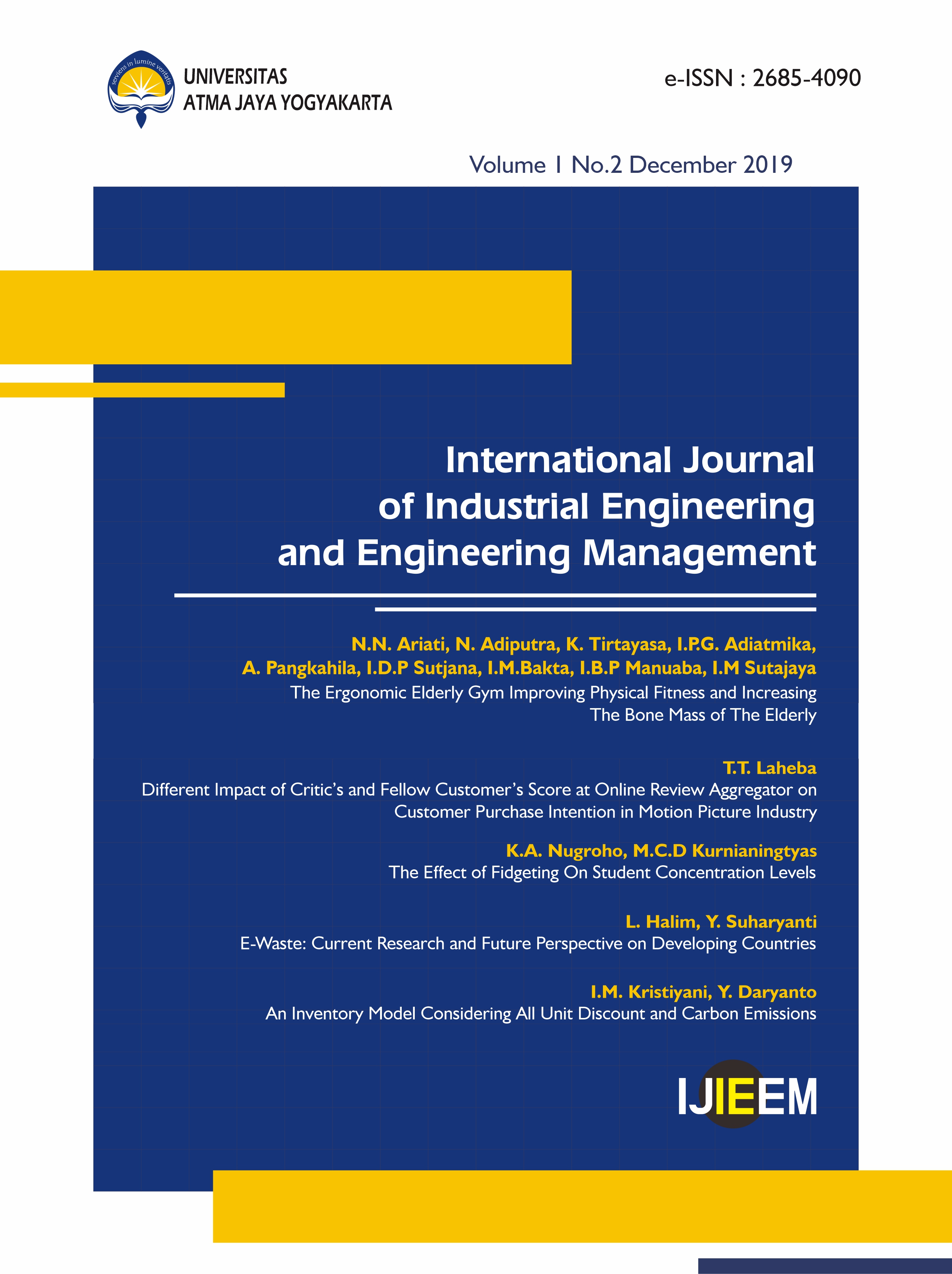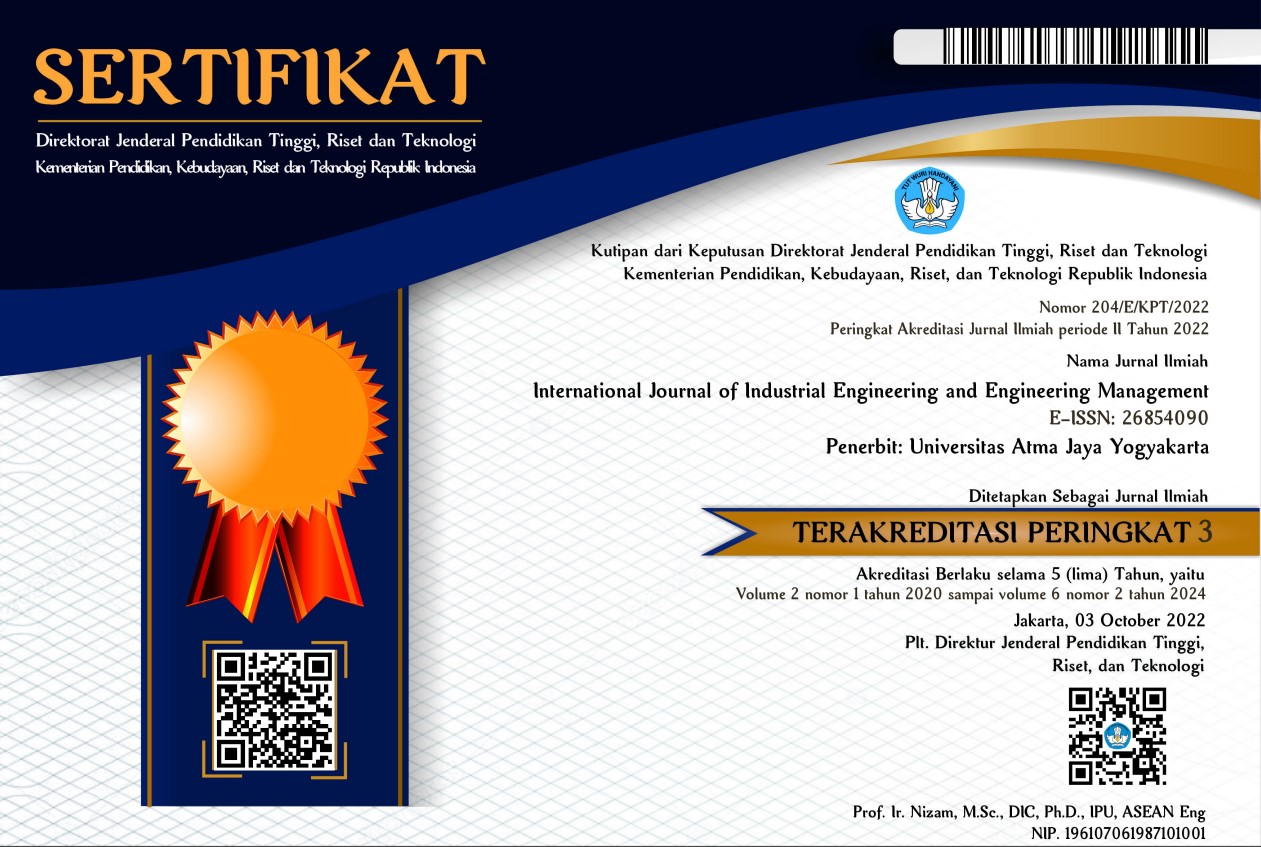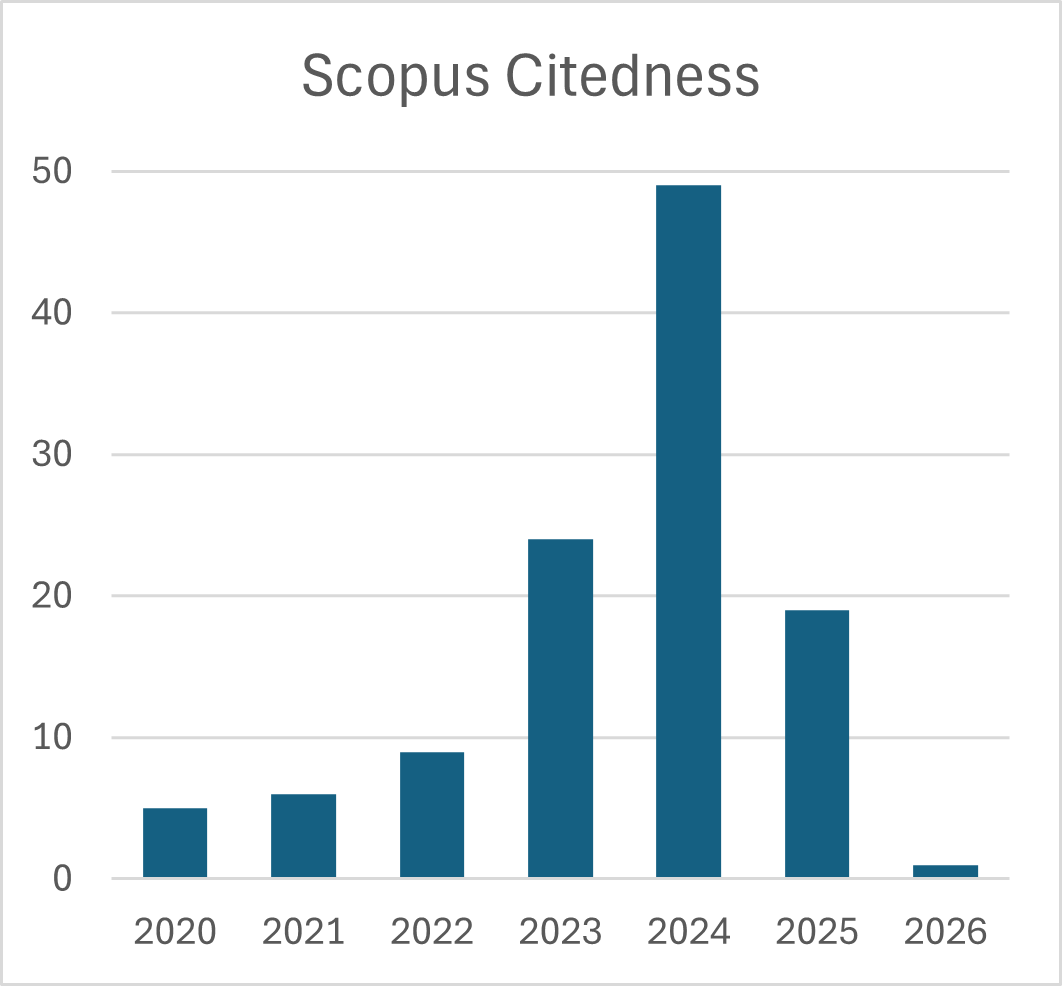E-Waste: Current Research and Future Perspective on Developing Countries
DOI:
https://doi.org/10.24002/ijieem.v1i2.3214Keywords:
e-waste, WEEE, research review, developing countriesAbstract
Increase of population, purchasing power, and development of technology give consequence to Waste of Electronic and Electrical Equipment (WEEE) or e-waste generation. Increasing rate of e-waste production and its hazardous content raise the concern regarding e-waste. This paper aims to describe the research development on e-waste in various countries and propose the perspective of future research. The study based on literature survey in open access journals using ‘e-waste’ as the keyword. Article selection was done by considering the reputability of the source and cited frequency. From the articles reviewed, China contributed to most of the researches. Some of most studied topic namely e-waste management, e-waste impact to human health and environment and current status of e-waste treatment in specific country. Brief explanation on each topic and insight on future research are also provided.
References
Alamerew, Y.A. and Brissaud, D. (2018). Modelling and Assessment of Product Recovery Strategies through Systems Dynamics. Procedia CIRP, 69, 822 – 826.
Alvarez-de-los-Mozos, E. and Renteria, A. (2017). Collaborative robots in e-waste management. Procedia Manufacturing, 11, 55-62.
An, T., Huang, Y., Li,. G., He, Z., Chen, J., and Zhang C. (2014). Pollution profiles and health risk assessment of VOCs emitted during e-waste dismantling processes associated with different dismantling methods. Environment International, 73, 180-194.
Andarani, P. and Goto, N. (2014). Potential e-waste generated from households in Indonesia using material flow analysis. Journal of Material Cycles and Waste Management, 16, 306-320.
Angouria-Tsorochidou, E., Cimpan, C., and Parajuly, K. (2018). Optimized collection of EoL electronic products for Circular economy: A techno-economic assessment. Procedia CIRP, 69, 986 – 991.
Awasthi, A.K., Hasan,M., Mishra, Y. K., Pandey, A.K., Tiwary, B.N. Kuhad, R. C., Gupta, V. K., and Thakur, V. K. (2019). Environmentally sound system for E-waste: Biotechnological perspectives. Current Research in Biotechnology, 1, 58–64.
Awasthi, A.K., Wang, M., Awasthi, M. K., Wang, Z., and Li, J. (2018). Environmental pollution and human body burden from improper recycling of e-waste in China: A short-review. Environmental Pollution, 243, Part B, 1310-1316.
Awasthi, A.K., Zeng, X., and Li, J. (2016). Comparative Examining and Analysis of E-waste Recycling in Typical Developing and Developed Countries. Procedia Environmental Sciences, 35, 676-680.
Barletta, I., Johansson,B., Reimers, J., Stahre,J., and Berlin, C. (2015). Prerequisites for a high-level framework to design sustainable plants in the e-waste supply chain. Procedia CIRP, 29, 633-638.
Barwod,M.,Li,J., Pringle,T., and Rahimifard, S. (2015). Utilisation of reconfigurable recycling sytems for improved material recovery from e-waste. Procedia CIRP, 29, 746-751.
Bhat, V. and Patil, Y. (2014). E-waste consciousness and disposal practices among residents of Pune city. Procedia - Social and Behavioral Sciences, 133, 491-498.
Bhat, V., Rao, P., Patil,Y. (2012). Development of an integrated model to recover precious metals from electronic scrap-A novel strategy for e-waste management. Procedia - Social and Behavioral Sciences, 37, 397-406.
Bhutta, M. K, Omar, A., and Yang, X. (2011). Electronic Waste: A Growing Concern in Today’s Environment. Economic Research International.
Börner,L. and Hegger, D. L.T. (2018). Toward design principles for sound e-waste governance: A research approach illustrated with the case of the Netherlands. Resources, Conservation & Recycling, 134, 271-281.
Budijati, S.M., Wibisono, M. A., and Masruroh, N. A. (2015). A Study of Consumers' Post Consumption Behaviour for Mobile Phone in Indonesia. Industrial Engineering, Management Science and Applications 2015, 563-573.
Charles, R. G., Douglas, P., Hallin, I. L., Matthews, I., and Liversage, G. (2017). An investigation of trends in precious metal and copper content of RAM modules in WEEE: Implications for long term recycling potential. Waste Management, 60, 505-520.
Chibunna, J. B., Siwar, C., Begum, R. A., and Mohamed, A. F. (2012). The Challenges of e-waste management among institutions: a case study of UKM. Procedia - Social and Behavioral Sciences, 59, 644-649.
Cole, C., Gnanapragasam, A., and Cooper, T. (2017). Towards a circular economy: exploring routes to reuse for discarded electrical and electronic equipment. Procedia CIRP, 61, 155-160.
Cole, C., Gnanapragasam, A., Singh, J., and Cooper, T. (2018). Enhancing reuse and resource recovery of electrical and electronic equipment with reverse logistics to meet carbon reduction targets. Procedia CIRP, 69, 980-985.
Cucchiella, F., D’Adamo, I, Koh, S.C. L, and Rosa, P. (2015). Recycling of WEEEs: An economic assessment of present and future e-waste streams. Renewable and Sustainable Energy Review, 51, 263-272.
Cyganowski, P., Garbera, K., Leśniewicz, A., Wolska,J., Pohl, P., Jermakowicz-Bartkowiak, D. (2017). The recovery of gold from the aqua regia leachate of electronic parts using a core–shell type anion exchange resin. Journal of Saudi Chemical Society, 21, 741–750.
Debnath, B., Roychoudhuri, R., and Ghosh, S. K. (2016). E-Waste Management- A Potential Route to Green Computing. Procedia Environmental Sciences, 35, 669-675.
Dwivedy, M. and Mittal, R. K. (2012). An investigation into e-waste flows in India. Journal of Cleaner Production, 37, 229-242.
Ercan, O. and Bllen, K. (2014). A research on electronic waste awareness and environmental attitudes of primary school students. Anthropologist, 17, 13-23.
Evangelopoulos,P., Kantarelis, E., and Yang, W. (2017). Experimental investigation of pyrolysis of printed circuit boards for energy and materials recovery under nitrogen and steam atmosphere. Energy Procedia, 105, 986-991.
Gaidajis, G., Angelakoglou, K., and Aktsoglou, D. (2010). E-Waste: Environmental Problems and Current Management. Journal of Engineering Science and Technology Review, 3, 193-199.
Gangwar, C., Choudhari, R., Chauhan, A., Kumar, A., Singh, A., and Tripathi, A. (2019). Assessment of air pollution caused by illegal e-waste burning to evaluate the human health risk. Environment International, 125, 191-199.
Gao,Y., Ge, l., Shi, S., Sun,Y., Liu,M., Wang,B., Shang, Y., Wu,J., and Tian, J. (2019). Global trends and future prospects of e-waste research: a bibliometric analysis. Environmental Science and Pollution Research, 26, 17809-17820.
Garlapati, V. K. (2016). E-Waste in India and developed countries: Management, recycling, business, and biotechnological initiatives. Renewable and Sustainable Energy Review, 54, 874-881.
Gnoni, M. G., Mossa, G., Mummolo, G., Tornese, F., and Verriello, R. (2017). Supporting circular economy through use-based business models: the washing machines case. Procedia CIRP, 64, 49 – 54.
Gonda, L and Degrez, M. (2018). End-of-life management of computers in Brussels: environmental comparison of two treatment chains. Procedia CIRP, 69, 968 – 973.
Grant, K., Coldizen, F. C., Sly, P. D., Brune, M. B., Neira, M., van den Berg, M., and Norman, R.E. (2013). Health consequences of expose to e-waste: a systematic review. Lancet Global Health, 1, 350–361.
Grant, R. (2019). E-Waste challenges in Cape Town: Opportunity for the green economy?. Urbani Izziv, 30, 5-23.
Hanafi, J., Kristina, H. J., Jobiliong, E., Christiani, A., Halim, A. V., Santoso, D., and Melini, E. (2011). The Prospects of Managing WEEE in Indonesia. Proceedings of the 18th CIRP International Conference on Life Cycle Engineering, Technische Universität Braunschweig, Braunschweig, Germany, May 2nd - 4th, 2011.
Hanafi, J., Christiani, A., Kristina, H. J., and Utama, K.P. (2014). Collecting End-of-Life Mobile Phones in Jakarta: A Pilot. Re-engineering Manufacturing for Sustainability, 365-370.
He, M., Yang, S., Zhao, J., Collins,C., Xu, J., and Liu, X.(2019). Reduction in the exposure risk of farmer from e-waste recycling site following environmental policy adjustment: A regional scale view of PAHs in paddy fields. Environment International, 133.
Hossain, M. S., Al-Hamadani S.M.Z.F., and Rahman, M. T. (2015). E-Waste: A Challenge for Sustainable Development. Journal of Health & Pollution, 5, 3-11.
Idrees, N., Tabassum,B., Abd_Allah, E. F., Hasehm, A., Sarah, R., and Hashim, M. (2018). Groundwater contamination with cadmium concentrations in some West U.P. Regions, India. Saudi Journal of Biological Sciences, 25, 1365–1368.
Ilankoon, I.M. S. K., Ghorbani, Y., Chong, M.N., Herath, G., Moyo, T., and Petersen, J.(2018). E-waste in the international context – A review of trade flows, regulations, hazards, waste management strategies and technologies for value recovery. Waste Management, 82, 258-275.
Jaiswal, A., Samuel, C., Patel, B. S., and Kumar, M. (2015). Go Green with WEEE: Eco-friendly approach for handling e-waste. Procedia Computer Science, 46, 1317-1324.
Jibiri,N. N., Isinkaye, M.O, and Momoh, H. A. (2014). Assessment of radiation exposure levels at Alaba e-waste dumpsite in comparison with municipal waste dumpsites in southwest Nigeria. Journal of Radiation Research and Applied Sciences, 7, 536-541.
Julander, A., Lundgren, L., Skare, L., Grancér, M., Palm, B., Vahter, M., and Lidén, C. (2014). Formal recycling of e-waste leads to increased exposure to toxic metals: An occupational exposure study from Sweden. Environmental International, 73, 243-251.
Kamigaki, K., Matsumoto, M., and Fatimah, Y. A. (2017). Remanufacturing and Refurbishing in Developed and Developing Countries in Asia – A Case Study in Photocopiers. Procedia CIRP, 61, 645 – 650.
Kang, J. J., Lee, J. S., Wang, W. S., Park, S. W., Alam, M. T., Back, S. K., Choi, H. S., Seo, Y. C., Yun, Y. S., Gu,J.H., Saravanakumar, A., and Kumar, K. V. (2016). A Study on Environmental Assessment of Residue from Gasification of Polyurethane Waste in E-Waste Recycling Process. Procedia Environmental Sciences, 35, 639-642.
Khanna, R., Cayumil, R., Mukherjee, P. S., and Sahajwalla,V. (2014). A novel recycling approach for transforming waste printed circuit boards into a material resource. Procedia Environmental Sciences, 21, 42 – 54.
Khatri, B. R., Sodha, A.B., Shah, M. B., Tipre, D.R., and Dave, S. R. (2018). Chemical and microbial leaching of base metals from obsolete cell-phone printed circuit boards. Sustainable Environment Research, 28, 333-339.
Kiddee, P., Naidu, R., and Wong, M. H. (2013). Electronic waste management approaches: An overview. Waste Management, 33, 1237-1250.
Kojima, M., Yoshida, A., and Sasaki, S. (2009). Difficulties in applying extended producer responsibility policies in developing countries: case studies in e-waste recycling in China and Thailand. Journal of Material Cycles and Waste Management, 11: 263-269.
Kong, S., Liu, H., Zeng,H., and Liu,Y. (2012). The Status and Progress of Resource Utilization Technology of E-Waste Pollution in China. Procedia Environmental Sciences, 16, 515-521.
Lepawsky, J. (2012). Legal geographies of e-waste legislation in Canada and the US:Jurisdiction, responsibility and the taboo of production. Geoforum, 43, 1194-1206.
Li, B., Du, H. Z., Ding, H.J., and Shi, M.Y. (2011). E-Waste Recycling and Related Social Issues in China. Energy Procedia, 5. 2527-2531.
Li, J., Li, W., Gao, X., Liu, L., Shen, M., Chen, H., Zhu, M., Zeng, L., and Zeng. E. Y. (2020). Occurrence of multiple classes of emerging photoinitiators in indoor dust from E-waste recycling facilities and adjacent communities in South China and implications for human exposure. Environment International, 136.
Li, R.C. and Tee, T. J. C. (2012). A Reverse Logistics Model for Recovery Options of E-Waste Considering the Integration of the Formal and Informal Waste Sectors. Procedia - Social and Behavioral Sciences, 40, 788-816.
Li, X., Duan, Y., Sun,H., Zhang, P., Xu, J., Hua, X., Jin, L., and Li, M. (2019). Human exposure levels of PAEs in an e-waste recycling area: Get insight into impacts of spatial variation and manipulation mode. Environment International, 133.
Lin, M., Tang,J., Ma, S., Yu, Y., Li, G., Fan,R., Mai, B., and An, T. (2019). Insights into biomonitoring of human exposure to polycyclic aromatic hydrocarbons with hair analysis: A case study in e-waste recycling area. Environment International, 136.
Liu, R., Li, J., and Ge, Z. (2016). Review on chromobacterium violaceum for gold bioleaching from e-waste. Procedia Environmental Sciences, 31, 947-953.
Liu, Y., Tang, B., Liu, Y., Lup, X., Mai, B., Covaci, A., and Poma, G. (2019). Occurrence, biomagnification and maternal transfer of legacy and emerging organophosphorus flame retardants and plasticizers in water snake from an e-waste site. Environment International, 133.
Marconi, M., Favi, C., Germani, M., Mandolini, M., and Mengarelli, M. (2017). A collaborative End of Life platform to favour the reuse of electronic components. Procedia CIRP, 61, 166-171.
Marconi, M., Gregori, F., Germani, M., Papetti, A.,and Favi, C. (2018). An approach to favor industrial symbiosis: the case of waste electrical and electronic equipment. Procedia Manufacturing, 21, 502-509.
Mary, J.S. and Meenambal, T. (2016). Inventorisation of E-Waste and Developing a Policy-Bulk Consumer Perspective. Procedia Environmental Sciences, 35, 643-655.
Mmereki, D., Li, B., Baldwin, A., and Hong, L. (2016). The Generation, Composition, Collection, Treatment and Disposal System, and Impact of E-Waste. Part of Book E-Waste in Transition - From Pollution to Resource.
Monika and Kishore, J. (2010). E-Waste Management: As a Challenge to Public Health in India. Indian Journal of Community Medicine, 35.
Nguyen, D., Ha, V., Wiji, Y., and Huynh, T. (2017). Material flows from electronic waste: understanding the shortages for Extended Producer Responsibility Implementation in Vietnam. Procedia CIRP, 61, 651-656.
Otto, S., Kibbe, A., Henn, L., Hentschke, L., and Kaiser, F.G. (2018). The economy of E-waste collection at the individual level: A practice oriented approach of categorizing determinants of E-waste collection into behavioral costs and motivation. Journal of Cleaner Production, 204, 33-40.
Panambunan-Ferse, M., and Breiter, A. (2013). Assessing the side-effects of ICT development: E-waste production and management A case study about cell phone end-of-life in Manado, Indonesia. Technology in Society, 35 (3), 223-231.
Pandebesie, E. S., Indrihastuti, I., Wilujeng, A. A., and Warmadewanthi, I. (2019). Factors influencing community participation in the management of household electronic waste in West Surabaya, Indonesia. Environmental Science and Pollution Research, 26, 27930–27939.
Perkins, D. N., Drisse,M.B.,Nxele, T., and Sly, P.D. (2014). E-Waste: A Global Hazard. Annals of Global Health, 80, 286-295.
Realff, M.J., Raymond, M., and Ammons, J.C. (2004). E-Waste: an opportunity. Materials Today, 7, 40-45.
Rhee, S. W. (2016). Beneficial use practice of e-wastes in Republic of Korea. Procedia Environmental Sciences, 31, 707-714.
Rimantho, D., and Nasution, S.R. (2016). The Current Status of E-Waste Management Practice in DKI Jakarta. International Journal of Applied Environmental Sciences, 11, 1451-1468.
Rochman, F.F., Ashton, W.S., and Wiharjo, M. G.M. (2017). E-waste, money,and power: Mapping electronic waste flows in Yogyakarta, Indonesia. Environmental Development, 24, 1-8.
Rode, S. (2012). E-Waste Management in Mumbai Metropolitan Region: Constraints and Opportunities. Theoretical and Empirical Researches in Urban Management, Research Centre in Public Administration and Public Services, Bucharest, Romania, 7(2), 90-104.
Sahajwalla, V. and Gaikwad, V. (2018). The present and future of e-waste plastics recycling. Current Opinion in Green and Sustainable Chemistry, 13, 102-107.
Salhofer, S. (2017). E-Waste Collection and Treatment Options: A Comparison Approaches in Europe, China, and Vietnam. Part of The Handbook of Environmental Chemistry book series Vol 63.
Santoso, S., Zagloel, T. Y. M., Ardi, R., and Suzianti, A. (2019). Estimating the Amount of Electronic Waste Generated in Indonesia: Population Balance Model. IOP Conference Series: Earth and Environmental Science, 219.
Sharpe, R.G., Goodall, P. A., Neal, A. d., Conway, P. P., and West, A. A. (2018). Cyber-physical systems in the re-use, refurbishment, and recycling of used Electrical and Electronic Equipment. Journal of Cleaner Production, 170, 351-361.
Shevchenko, T., Laitala, K., and Danko,Y. (2019). Understanding Consumer E-Waste Recycling Behavior: Introducing a New Economic Incentive to Increase the Collection Rates. Sustainability, 11.
Someya, M., Suzuki, G., Ionas, A. C., Tue, N. M., Xu,F., Matsukami, H., Covaci, A., Tuyen, L.H., Viet, P.H., Takahashi, S., Tanabe, S., and Takigami, H. (2016). Occurrence of emerging flame retardants from e-waste recycling activities in the northern part of Vietnam. Emerging Contaminants, 2, 58-65.
Sothun, C. (2012). Situation of e-waste management in Cambodia. Procedia Environmental Sciences, 16, 535-544.
Suzuki, G., Masayuki, S., Matsukami, H.,Tue, N.M., Natsuyo, U., Tuyen, L.H., Viet,P.H., Takahashi, S., Tanabe,S., Brouwer, A., and Takigami, H. (2016). Comprehensive evaluation of dioxins and dioxin-like compounds in surface soils and river sediments from e-waste processing sites in a village in northern Vietnam: Heading towards the environmentally sound management of e-waste. Emerging Contaminants, 2, 98-108.
Terazono,A., Murakami, S., Ahe,N., Inane, B., Moriguchi, Y., Sakai, S., Kojima, M., Yoshida, A., Li,J., Xang, J., Wung, M., Jain, A., Kim, I., Peralta, G.L., Line, C., Mungcharoen, and T., Wiliams, E. (2006). Current status and research on E-Waste issues in Asia. Journal of Material Cycles and Waste Management, 8, 1-12.
Torihara, K., Kitajima,T., and Mishima, N. (2015). Design of a Proper Recycling Process for Small-Sized E-Waste. Procedia CIRP, 26, 746-751.
Tue,N.M., Takahashi,S., Suzuki, G., Isobe, T., Viet, P.H., Kobara, Y., Seike, N., Zhang,G., Sudaryanto, A., and Tanabe, S. (2013). Contamination of indoor dust and air by polychlorinated biphenyls and brominated flame retardants and relevance of non-dietary exposure in Vietnamese informal e-waste recycling sites. Environment International, 51, 160-167.
Uchida, N., Matsukami, H., Someya, M., Tue, N. M., Tuyen, L. H., Viet, P. H., Takahashi, S., Tanabe, S., and Suzuki, G. (2018). Hazardous metals emissions from e-waste-processing sites in a village in northern Vietnam. Emerging Contaminants, 4, 11-21.
Vanegas, P., Peeters, J. R., Plessers, F., Cattrysse,D., and Duflou, J. R. (2014). Synergizing industrialized and developing countries to improve resource recovery for e-waste: case study Belgium-Kenya. Procedia CIRP, 15, 283-288.
Vats, M.C., and Singh S.K. (2014). E-waste characteristic and its disposal. International Journal of Ecological Science and Environmental Engineering.
Veenstra, A., Wang, C., Fan, W., and Ru,Y. (2010). An Analysis of E-Waste Flows in China. International Journal of Advanced Manufacturing Technology, 47, 449-459.
Wang, X., and Wang, L. (2019). Digital twin-based WEEE recycling, recovery and remanufacturing in the background of Industry 4.0. International Journal of Production Research.
Wang, Y., Sun, X., fang, L., Li, K., Yang, P., Du, L., Ji, K., Wang, J. Liu, Q., Xu, C., Li, G., Giesy, J. P., and Hecker, M. (2018). Genomic instability in adult men involved in processing electronic waste in Northern China. Environment International, 117, 69–81.
Wei, L. and Liu, Y. (2012). Present status of e-waste disposal and recycling in China. Procedia Environmental Sciences, 16, 506-514.
Wu, Y., Fang, Q., Yi,X., Liu, G., and Li, R. (2017). Recovery of gold from hydrometallurgical leaching solution of electronic waste via spontaneous reduction by polyaniline. Progress in Natural Science: Materials International, 27, 514–519.
Yamasita, T., Sakugawa, T., Akiyama, H., and Hosano, H. (2019). Metal-coated plastics recycling by pulsed electric discharge. Waste Management, 89, 57-63.
Yao, Z., Xie, Z., and Tang, J. (2016). A typical e-waste-cathode ray tube glass: alkaline leaching in the sulfur-containing medium. Procedia Environmental Sciences, 31, 880 – 886.
Yoshida, A., Terazono, A., Ballesteros Jr., F. C., Nguyen, D., Sukandar, S., Kojima, M., and Sakata, S. (2016). E-waste recycling processes in Indonesia, the Philippines, and Vietnam: A case study of cathode ray tube TVs and monitors. Resources, Conservation and Recycling, 106, 48–58.
Zeng, X., Duan,H., Wang, F., and Liu, L. (2016). Examining enviromental management of e-waste: China's experience and lessons. Renewable and Sustainable Energy Reviews, 72, 1076-1082.
Zeng, X., Song, Q., Yuan, W., Duan, W., and Liu, L. (2015). Solving e-waste problem using an integrated mobile recycling plant. Journal of Cleaner Production, 90, 55-59.
Zhang, B., Zhang, T., Duan, Y., Zhao, Z., Huang, X., Bai, X., Xie, L., He,Y., Ouyang, J., Yang, Y., Wu, Y., and Sun, H. (2019). Human exposure to phthalate esters associated with e-waste dismantling: Exposure levels, sources, and risk assessment. Environment International, 124, 1-9.
Zhang, L., and Xu, Z. (2016). A Review of Current Progress of Recycling Technologies for Metals from Waste Electrical and Electronic Equipment. Journal of Cleaner Production, 127, 19-36.
Zhong, H., and Huang, L. (2016). The empirical research on the consumers' willingness to participate in E-waste recycling with a point reward system. Energy Procedia, 104, 475-480.








